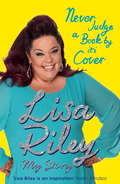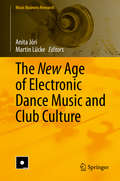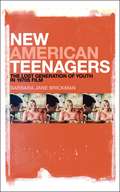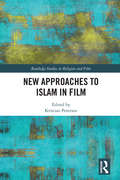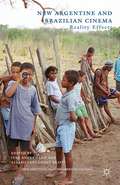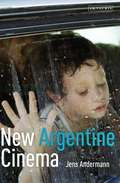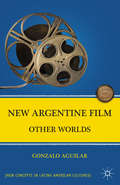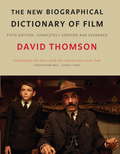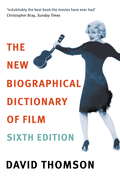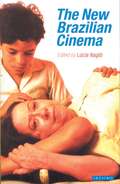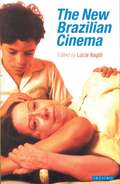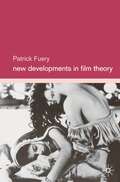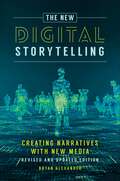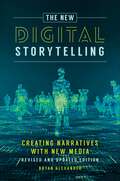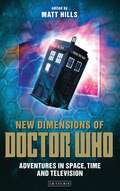- Table View
- List View
Never Judge a Book by its Cover: The Autobiography
by Lisa RileyThe story behind the nation's new darling - the former EMMERDALE and STRICTLY COME DANCING star, Lisa Riley.Lisa Riley won the hearts of the nation as she danced for her life, now it's time to read her life...NEVER JUDGE A BOOK BY ITS COVER is the inspirational and moving story of how a fairytale came true. From her beginnings in Bury, Lisa went on to become the darling of television and stage. But it was on STRICTLY COME DANCING that she wowed the nation with her energy, sparkle and never-ending enthusiasm.This talented lass from Bury has, at last, brought a real woman's figure to our screens and allowed women to say, 'this is me: take it or leave it'.Lisa's message is clear: whatever size you are, and whatever life throws at you, be who you want to be and stay true to yourself!
Never Let Me Go (Screenplay)
by Alex GarlandIn his highly acclaimed novel Never Let Me Go, Kazuo Ishiguro (The Remains of the Day) created a remarkable story of love, loss and hidden truths. In it he posed the fundamental question: What makes us human? Now director Mark Romanek (One Hour Photo), writer Alex Garland and DNA Films bring Ishiguro's hauntingly poignant and emotional story to the screen. Kathy (Oscar nominee Carey Mulligan, An Education), Tommy (Andrew Garfield, Boy A, Red Riding) and Ruth (Oscar nominee Keira Knightley, Pride & Prejudice, Atonement) live in a world and a time that feel familiar to us, but are not quite like anything we know. They spend their childhood at Hailsham, a seemingly idyllic English boarding school. When they leave the shelter of the school and the terrible truth of their fate is revealed to them, they must also confront the deep feelings of love, jealousy and betrayal that threaten to pull them apart.
The New Age of Electronic Dance Music and Club Culture (Music Business Research)
by Martin Lücke Anita JóriThis book offers a comprehensive overview of electronic dance music (EDM) and club culture. To do so, it interlinks a broad range of disciplines, revealing their (at times vastly) differing standpoints on the same subject. Scholars from such diverse fields as cultural studies, economics, linguistics, media studies, musicology, philosophy, and sociology share their perspectives. In addition, the book features articles by practitioners who have been active on the EDM scene for many years and discuss issues like gender and diversity problems in general, and the effects of gentrification on club culture in Berlin. Although the book’s main focus is on Berlin, one of the key centers of EDM and club culture, its findings can also be applied to other hotspots. Though primarily intended for researchers and students, the book will benefit all readers interested in obtaining an interdisciplinary overview of research on electronic dance music.
New American Teenagers: The Lost Generation of Youth in 1970s Film
by Barbara Jane BrickmanTaking a closer look at teen film in the 1970s, New American Teenagers uncovers previously marginalized voices that rework the classically male, heterosexual American teenage story. While their parents' era defined the American teenager with the romantic male figure of James Dean, this generation of adolescents offers a dramatically altered picture of transformed gender dynamics, fluid and queered sexuality, and a chilling disregard for the authority of parent, or more specifically, patriarchal culture. Films like The Rocky Horror Picture Show, Halloween, and Badlands offer a reprieve from the 'straight' developmental narrative, including in the canon of study the changing definition of the American teenager. Barbara Brickman is the first to challenge the neglect of this decade in discussions of teen film by establishing the subversive potential and critical revision possible in the narratives of these new teenage voices, particularly in regards to changing notions of gender and sexuality.
New American Teenagers: The Lost Generation of Youth in 1970s Film
by Barbara Jane BrickmanTaking a closer look at teen film in the 1970s, New American Teenagers uncovers previously marginalized voices that rework the classically male, heterosexual American teenage story. While their parents' era defined the American teenager with the romantic male figure of James Dean, this generation of adolescents offers a dramatically altered picture of transformed gender dynamics, fluid and queered sexuality, and a chilling disregard for the authority of parent, or more specifically, patriarchal culture. Films like The Rocky Horror Picture Show, Halloween, and Badlands offer a reprieve from the 'straight' developmental narrative, including in the canon of study the changing definition of the American teenager. Barbara Brickman is the first to challenge the neglect of this decade in discussions of teen film by establishing the subversive potential and critical revision possible in the narratives of these new teenage voices, particularly in regards to changing notions of gender and sexuality.
New Approaches to Cinematic Space (Routledge Advances in Film Studies)
by Filipa Rosário Iván Villarmea ÁlvarezNew Approaches to Cinematic Space aims to discuss the process of creation of cinematic spaces through moving images and the subsequent interpretation of their purpose and meaning. Throughout seventeen chapters, this edited collection will attempt to identify and interpret the formal strategies used by different filmmakers to depict real or imaginary places and turn them into abstract, conceptual spaces. The contributors to this volume will specifically focus on a series of systems of representation that go beyond the mere visual reproduction of a given location to construct a network of meanings that ultimately shapes our spatial worldview.
New Approaches to Cinematic Space (Routledge Advances in Film Studies)
by Filipa Rosário Iván Villarmea ÁlvarezNew Approaches to Cinematic Space aims to discuss the process of creation of cinematic spaces through moving images and the subsequent interpretation of their purpose and meaning. Throughout seventeen chapters, this edited collection will attempt to identify and interpret the formal strategies used by different filmmakers to depict real or imaginary places and turn them into abstract, conceptual spaces. The contributors to this volume will specifically focus on a series of systems of representation that go beyond the mere visual reproduction of a given location to construct a network of meanings that ultimately shapes our spatial worldview.
New Approaches to Islam in Film (Routledge Studies in Religion and Film)
by Kristian PetersenMany global film industries fail in expanding the role of Muslims on screen. Too often they produce a dichotomy between "good" and "bad" Muslims, limiting the narrative domain to issues of national security, war, and terrorism. Naturally, much of the previous scholarship on Muslims in film focused on stereotypes and the politics of representation. This collection of essays, from an international panel of contributors, significantly expands the boundaries of discussion around Muslims in film, asking new questions of the archive and magnifying analyses of particular cultural productions. The volume includes the exploration of regional cinemas, detailed analysis of auteurs and individual films, comparison across global cinema, and new explorations that have not yet entered the conversation. The interdisciplinary collection provides an examination of the multiple roles Islam plays in film and the various ways Muslims are depicted. Across the chapters, key intersecting themes arise that push the limits of how we currently approach issues of Muslims in cinema and ventures to lead us in new directions for future scholarship. This book adds new depth to the matrix of previous scholarship by revisiting methodological structures and sources, as well as exploring new visual geographies, transnational circuits, and approaches. It reframes the presiding scholarly conventions in five novel trajectories: considering new sources, exploring new communities, probing new perspectives, charting new theoretical directions, and offering new ways of understanding conflict in cinema. As such, it will be of great use to scholars working in Islamic Studies, Film Studies, Religious Studies, and Media.
New Approaches to Islam in Film (Routledge Studies in Religion and Film)
by Kristian PetersenMany global film industries fail in expanding the role of Muslims on screen. Too often they produce a dichotomy between "good" and "bad" Muslims, limiting the narrative domain to issues of national security, war, and terrorism. Naturally, much of the previous scholarship on Muslims in film focused on stereotypes and the politics of representation. This collection of essays, from an international panel of contributors, significantly expands the boundaries of discussion around Muslims in film, asking new questions of the archive and magnifying analyses of particular cultural productions. The volume includes the exploration of regional cinemas, detailed analysis of auteurs and individual films, comparison across global cinema, and new explorations that have not yet entered the conversation. The interdisciplinary collection provides an examination of the multiple roles Islam plays in film and the various ways Muslims are depicted. Across the chapters, key intersecting themes arise that push the limits of how we currently approach issues of Muslims in cinema and ventures to lead us in new directions for future scholarship. This book adds new depth to the matrix of previous scholarship by revisiting methodological structures and sources, as well as exploring new visual geographies, transnational circuits, and approaches. It reframes the presiding scholarly conventions in five novel trajectories: considering new sources, exploring new communities, probing new perspectives, charting new theoretical directions, and offering new ways of understanding conflict in cinema. As such, it will be of great use to scholars working in Islamic Studies, Film Studies, Religious Studies, and Media.
New Argentine and Brazilian Cinema: Reality Effects (New Directions in Latino American Cultures)
by Jens Andermann and Álvaro Fernández BravoReality Effects brings together the reflections of leading film scholars and critics from Latin America, the UK and the United States on the re-emergence of the real as a prime concern in contemporary Argentine and Brazilian film, and as a main reason for the acclaim both cinematographies have won among international audiences in recent years.
New Argentine Cinema (World Cinema)
by Jens AndermannArgentine filmmaking over the past two decades has enjoyed worldwide success. New Argentine Cinema explores this cinema from the mid-1990s to the present, from a film-analytical as well as a cultural studies perspective. it reveals the elements that have made for this success, in relation to the country's profound political, social and cultural crisis during the same period. Jens Andermann argues that cinema, more than any other art form, has proved a particularly effective medium for engaging with the way crisis has been lived and experienced, due to its own exposure to economic and technological change. Thus, the most recent wave of films also differs markedly from the Argentine cinema of the preceding decade, following the end of the dictatorship in 1983. Studying films including Lucrecia Martel's La ciénaga (The Swamp), Lisandro Alonso's La libertad (Freedom), Albertina Carri's Los rubios (The Blondes), Martín Rejtman's Sílvia Prieto and Pablo Trapero's Nacido y criado (Born and Bred), among others, he identifies a shift in aesthetic sensibilities between these directors and those of the previous generation, as well as a profound change in the way films are being made, and their relation to the audio-visual field at large. In combining close comparative analyses with a review of the changing models of production, editing, actorship and location, this book uncovers the ways in which Argentine films have managed to construct a complex, multilayered account of their own present, still troubled by the unresolved legacast.
New Argentine Film: Other Worlds (New Directions in Latino American Cultures)
by G. AguilarRespected film critic Gonzalo Aguilar offers a lucid and sophisticated analysis of Argentine films of the last decade. This is the most complete and up-to-date work in English to examine the "new Argentine cinema" phenomenon. Aguilar looks at highly relevant films, including recent award-winners at all of the major festivals.
New Austrian Film
by Robert Von Dassanowsky Oliver C. SpeckOut of a film culture originally starved of funds have emerged rich and eclectic works by film-makers that are now achieving the international recognition that they deserve: Barbara Albert, Michael Haneke, Ulrich Seidl, and Stefan Ruzowitzky, to give four examples. This comprehensive critical anthology, by leading scholars of Austrian film, is intended to introduce and make accessible this much under-represented phenomenon. Although the book covers the full development of the Austrian new wave it focuses on the period that has brought it global attention: 1998 to the present. New Austrian Film is the only book currently available on this topic and will be an essential reference work for academics, students and filmmakers, interested in modern Austrian film.
New Austrian Film
by Robert Von Dassanowsky Oliver C. SpeckOut of a film culture originally starved of funds have emerged rich and eclectic works by film-makers that are now achieving the international recognition that they deserve: Barbara Albert, Michael Haneke, Ulrich Seidl, and Stefan Ruzowitzky, to give four examples. This comprehensive critical anthology, by leading scholars of Austrian film, is intended to introduce and make accessible this much under-represented phenomenon. Although the book covers the full development of the Austrian new wave it focuses on the period that has brought it global attention: 1998 to the present. New Austrian Film is the only book currently available on this topic and will be an essential reference work for academics, students and filmmakers, interested in modern Austrian film.
The New Biographical Dictionary Of Film 5Th Ed
by David ThomsonThis book is both more and less than history, a work of imagination in its own right, a piece of movie literature that turns fact into romance.' Gavin Lambert was reviewing the first edition of David Thomson's monumental work in 1975. In the eight years since the third edition was published, careers have waxed and waned, reputations been made and lost, great movies produced, trends set and scorned.This fourth edition has 200 entirely new entries and every original entry has been re-examined. Thus the roster of directors, actors, producers, screenwriters and cameramen is both historical and contemporary, with old masters reappraised in terms of how their work has lasted.Each of the 1,000 profiles is a keenly perceptive, provocative critical essay. Striking the perfect balance between personal bias and factual reliability, David Thomson - novelist, critic, biographer and unabashed film addict - has given us an enormously rich reference book, a brilliant reflection on the art and artists of the cinema.
The New Biographical Dictionary Of Film 6th Edition: Fifth Edition, Completely Updated And Expanded
by David ThomsonWith more than one hundred new entries, from Amy Adams, Benedict Cumberbatch and Cary Joji Fukunaga to Joaquin Phoenix, Mia Wasikowska and Robin Wright, and completely updated, here from David Thomson - 'The greatest living writer on the movies' (John Banville, New Statesman); 'Our most argumentative and trustworthy historian of the screen' (Michael Ondaatje) - is the latest edition of The New Biographical Dictionary of Film, which topped Sight & Sound's poll of international critics and writers as THE BEST FILM BOOK EVER WRITTEN.
The New Brazilian Cinema
by Lúcia NagibLucia Nagib presents a comprehensive critical survey of Brazilian film production since the mid 1990s, which has become known as the "renaissance of Brazilian cinema". Besides explaining the recent boom, this book elaborates on the new aesthetic tendencies of recent productions, as well as their relationships to earlier traditions of Brazilian cinema. Internationally acclaimed films, such as "Central Station", "Seven Days in September" and "Orpheus", are analysed alongside daringly experimental works, such as "Chronically Unfeasible", "Starry Sky" and "Perfumed Ball". Contributors include Carlos Diegues, Robert Stam, Laura Mulvey and Jose Carlos Avellar.
The New Brazilian Cinema
by Lúcia NagibSince the mid-1990s, Brazil has produced nearly 200 feature length films. Many of these have been received enthusiastically by audiences and critics and released worldwide. This passionately argued and illuminating book provides the first comprehensive critical account of what is known as the 'Renaissance of Brazilian cinema' and demonstrates just how thought-provoking and inspiring Brazilian cinema has become.The book looks at the broader political and policy-making issues for this dynamic new cinema. It also offers close analyses of internationally acclaimed films like Central Station, Seven Days in September, Orfeu and Me You Them and investigates daringly experimental works, such as Chronically Unfeasible, Starry Sky and Perfumed Ball. It examines common factors across a great variety of films, including film makers' engagement with national identity, a major concern for the Cinema Novo of the 1960s, which has emerged in contemporary films with new relevance in a globalized world.The contributors include film and cultural policy-makers who have participated in the Brazilian film revival as well as film scholars and journalists, giving a variety of readings of films, movements or filmmakers, stimulating debate and presenting throughout contrasting, even opposing viewpoints.The beauty of Nagib's book makes readers want to seek out the films being described…a valuable collection. - Film International
New British Cinema from 'Submarine' to '12 Years a Slave': The Resurgence of British Film-making
by Jason Wood Ian Haydn SmithOver the past year the success of British films at international film festivals - as well as the numerous awards bestowed on 12 Years a Slave - have demonstrated that British cinema has undergone a genuine renaissance that has caused new voices to emerge. At the same time, directors whose work has enthralled over the past five years have also continued to develop and expand their visions. The boundaries of British film-making are being redefined.Beginning with a preface exploring some of the factors that have led to this fertile environment, New British Cinema features in-depth interviews with the film-making voices at the vanguard of this new wave. Figures such as Clio Barnard, Richard Ayoade, Steve McQueen, Jonathan Glazer, Carol Morley, Yann Demange, Peter Strickland and Ben Wheatley provide a valuable insight into their work and working methods.
New Chinese-Language Documentaries: Ethics, Subject and Place (Media, Culture and Social Change in Asia)
by Kuei-fen Chiu Yingjin ZhangDocumentary filmmaking is one of the most vibrant areas of media activity in the Chinese world, with many independent filmmakers producing documentaries that deal with a range of sensitive socio-political problems, bringing to their work a strongly ethical approach. This book identifies notable similarities and crucial differences between new Chinese-language documentaries in mainland China and Taiwan. It outlines how documentary filmmaking has developed, contrasts independent documentaries with dominant official state productions, considers how independent documentary filmmakers go about their work, including the work of exhibiting their films and connecting with audiences, and discusses the content of their documentaries, showing how the filmmakers portray a wide range of subject matter regarding places and people, and how they deal with particular issues including the underprivileged, migrants and women in an ethical way. Throughout the book demonstrates how successful Chinese-language independent documentary filmmaking is, with many appearances at international film festivals and a growing number of award-winning titles.
New Chinese-Language Documentaries: Ethics, Subject and Place (Media, Culture and Social Change in Asia)
by Kuei-fen Chiu Yingjin ZhangDocumentary filmmaking is one of the most vibrant areas of media activity in the Chinese world, with many independent filmmakers producing documentaries that deal with a range of sensitive socio-political problems, bringing to their work a strongly ethical approach. This book identifies notable similarities and crucial differences between new Chinese-language documentaries in mainland China and Taiwan. It outlines how documentary filmmaking has developed, contrasts independent documentaries with dominant official state productions, considers how independent documentary filmmakers go about their work, including the work of exhibiting their films and connecting with audiences, and discusses the content of their documentaries, showing how the filmmakers portray a wide range of subject matter regarding places and people, and how they deal with particular issues including the underprivileged, migrants and women in an ethical way. Throughout the book demonstrates how successful Chinese-language independent documentary filmmaking is, with many appearances at international film festivals and a growing number of award-winning titles.
New Developments in Film Theory
by Patrick FueryThis book examines some of the most significant recent developments in film and critical theory. The book is divided into four sections, each dealing with established and alternative critical concepts and approaches. These four are: The Gaze and Subjectivity; Film and Discourse; Film and Culture; Film and Meaning. Each of these topics is explored using concepts from post-structuralism and postmodernism, working towards the idea that the relationship between film studies and critical theory is a vital and diverse interplay of rich and exciting ideas.
The New Digital Storytelling: Creating Narratives with New Media--Revised and Updated Edition
by Bryan AlexanderNewly revised and updated, this is the essential guide to state-of-the-art digital storytelling for audiences, creators, and teachers.Written for everyone interested in the communication potential of digital media, including educators, marketers, communication professionals, and community activists, this is the ultimate guide to harnessing technology for storytelling. No other book covers the digital storytelling movement as thoroughly as this updated second edition of a popular work, nor does any incorporate as many technologies, from video to augmented reality, mobile devices to virtual reality.The book combines history, analysis, and practical guidance about digital storytelling. It begins with a history that encompasses an exploration of storytelling itself, as well as a description of narratives using digital tools from the 1980s through 2000. From there, the author dives into modern digital storytelling, offering analysis and guidance regarding the use of digital video, podcasting, social media, gaming, mobile devices, and virtual and augmented reality. The work concludes with practical advice about how to create and share digital stories using the most current tools so even the new would-be storyteller can create their first digital narrative. Of course, the second edition is updated to take into account the many ways the field has advanced since the original book appeared. With many new examples of digital stories, this edition's evidence base is current and fresh. New or transformed technologies are also addressed, including virtual reality; mobile devices that have become mainstream tools for creating, sharing, and experiencing digital stories; and the wide variety of new storytelling apps and services.
The New Digital Storytelling: Creating Narratives with New Media--Revised and Updated Edition
by Bryan AlexanderNewly revised and updated, this is the essential guide to state-of-the-art digital storytelling for audiences, creators, and teachers.Written for everyone interested in the communication potential of digital media, including educators, marketers, communication professionals, and community activists, this is the ultimate guide to harnessing technology for storytelling. No other book covers the digital storytelling movement as thoroughly as this updated second edition of a popular work, nor does any incorporate as many technologies, from video to augmented reality, mobile devices to virtual reality.The book combines history, analysis, and practical guidance about digital storytelling. It begins with a history that encompasses an exploration of storytelling itself, as well as a description of narratives using digital tools from the 1980s through 2000. From there, the author dives into modern digital storytelling, offering analysis and guidance regarding the use of digital video, podcasting, social media, gaming, mobile devices, and virtual and augmented reality. The work concludes with practical advice about how to create and share digital stories using the most current tools so even the new would-be storyteller can create their first digital narrative. Of course, the second edition is updated to take into account the many ways the field has advanced since the original book appeared. With many new examples of digital stories, this edition's evidence base is current and fresh. New or transformed technologies are also addressed, including virtual reality; mobile devices that have become mainstream tools for creating, sharing, and experiencing digital stories; and the wide variety of new storytelling apps and services.
New Dimensions of Doctor Who: Adventures in Space, Time and Television (Reading Contemporary Television Ser.)
by Matt HillsThe Doctor may have regenerated on many occasions, but so too has Doctor Who. Moving with the times, the show has evolved across fifty years. New Dimensions of Doctor Who brings together experts on the Doctors, on TV brands, bioethics, transmedia, and cultural icons to explore contemporary developments in the series' music, design and representations of technology, plus issues of showrunner authority and star authorship. Putting these new dimensions into context means thinking about changes in the TV industry such as the rise of branding and transmedia storytelling. Along with its faster narrative pace, and producer/fan interaction via Twitter, 'new Who' also has a new home: Roath Lock Studios at Cardiff Bay. Studying the Doctor Who Experience in its Cardiff setting, and considering audience nostalgia alongside anniversary celebrations, this book explores how current Doctor Who relates to real-world spaces and times.
